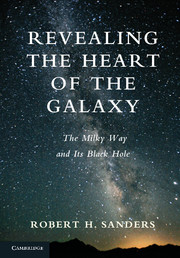Book contents
- Frontmatter
- Contents
- Acknowledgements
- 1 Introduction: The Luminous Pathway
- 2 The Discovery of the Milky Way Galaxy
- 3 The New Physics
- 4 Parting the Veil with Radio Astronomy
- 5 The Violent Universe
- 6 New Windows on the Galactic Center
- 7 The Milky Way as a Barred Spiral Galaxy
- 8 The Evolving View of Active Galactic Nuclei
- 9 The “Paradox of Youth”: Young Stars in the Galactic Center
- 10 Stellar Orbits in the Galactic Center, QED
- 11 Black Holes Here, Black Holes There…
- 12 Traces of Activity: Past, Present, and Future
- 13 After Words: Progress in Astronomy
- References
- Index
7 - The Milky Way as a Barred Spiral Galaxy
Published online by Cambridge University Press: 05 December 2013
- Frontmatter
- Contents
- Acknowledgements
- 1 Introduction: The Luminous Pathway
- 2 The Discovery of the Milky Way Galaxy
- 3 The New Physics
- 4 Parting the Veil with Radio Astronomy
- 5 The Violent Universe
- 6 New Windows on the Galactic Center
- 7 The Milky Way as a Barred Spiral Galaxy
- 8 The Evolving View of Active Galactic Nuclei
- 9 The “Paradox of Youth”: Young Stars in the Galactic Center
- 10 Stellar Orbits in the Galactic Center, QED
- 11 Black Holes Here, Black Holes There…
- 12 Traces of Activity: Past, Present, and Future
- 13 After Words: Progress in Astronomy
- References
- Index
Summary
Ejections and Explosions
The discipline of astronomy is replete with unconventional personalities. The Armenian astrophysicist Victor Ambartsumian (Figure 7.1), who had a highly respectable career behind him by the mid-twentieth century, was certainly one such character. In 1958 he presented a paper at the prestigious Solvay conference in Belgium on the role of activity in galactic nuclei in shaping the structure and evolution of the surrounding galaxy; he proposed that spiral structure is formed by ejections from the nuclei of galaxies and that, in extreme cases, new blue galaxies are “born” (ejected) from the centers of giant galaxies. This all seemed quite bizarre at the time but the concurrent discovery of radio galaxies and, several years later, of quasars gave support to the less radical idea that many galaxies appear to undergo sudden impulsive events involving mass ejection, often in two opposite directions.
This was an initial interpretation of the morphology of radio galaxies, where two enormous lobes of radio emission are often observed beyond and on opposite sides of the visible object, generally an elliptical galaxy (see Figure 5.4 of Cygnus A). An early model involved the explosive ejection of two oppositely directed clouds of ionized gas and relativistic particles that are confined by ram pressure of supersonic motion through an ambient intergalactic medium. The amount of energy involved in such events would be huge, much larger than the rest mass energy of one million suns directly observed as relativistic particles.
- Type
- Chapter
- Information
- Revealing the Heart of the GalaxyThe Milky Way and its Black Hole, pp. 83 - 98Publisher: Cambridge University PressPrint publication year: 2013



